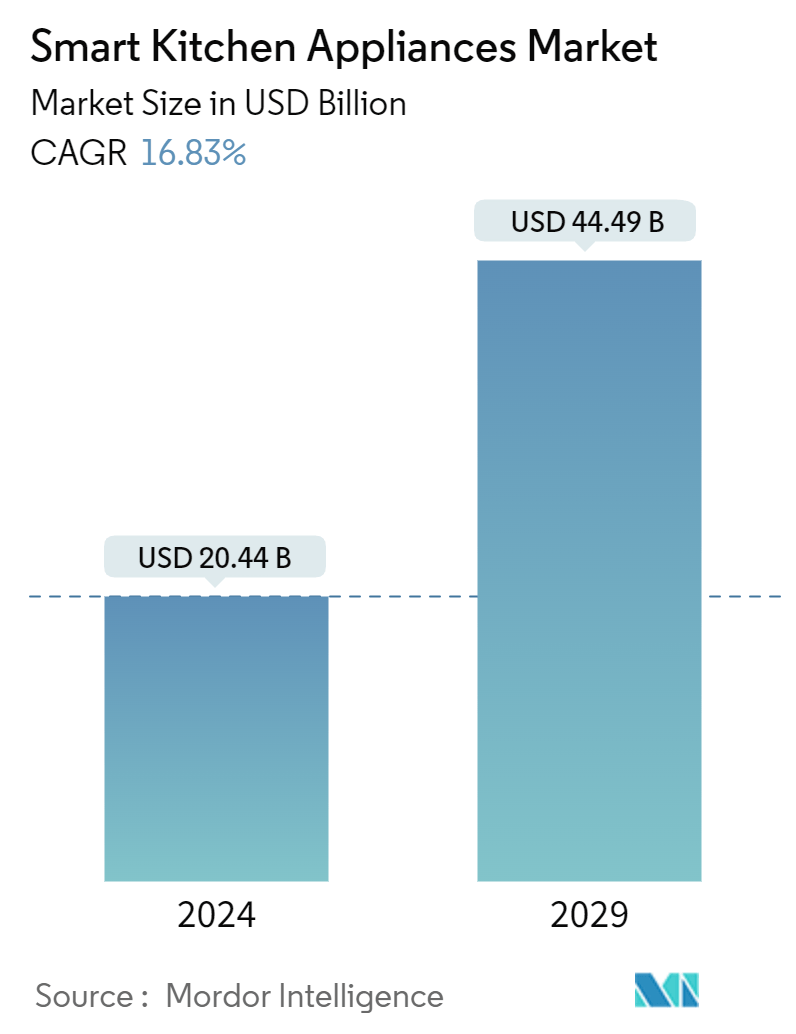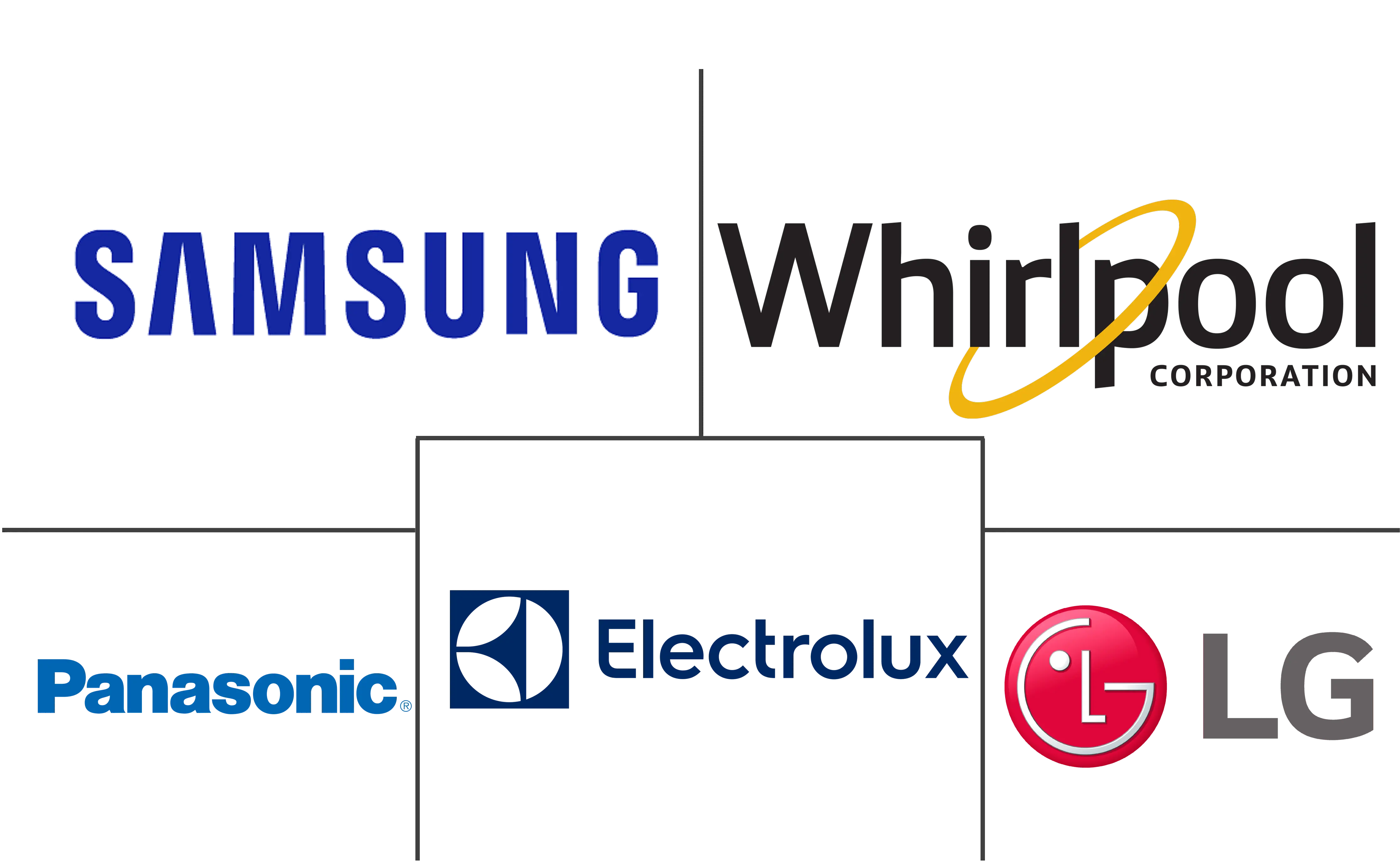Market Size of Smart Kitchen Appliances Industry

| Study Period | 2020 - 2029 |
| Market Size (2024) | USD 20.44 Billion |
| Market Size (2029) | USD 44.49 Billion |
| CAGR (2024 - 2029) | 16.83 % |
| Fastest Growing Market | Asia Pacific |
| Largest Market | North America |
| Market Concentration | Low |
Major Players
*Disclaimer: Major Players sorted in no particular order |
Smart Kitchen Appliances Market Analysis
The Smart Kitchen Appliances Market size is estimated at USD 20.44 billion in 2024, and is expected to reach USD 44.49 billion by 2029, growing at a CAGR of 16.83% during the forecast period (2024-2029).
With rapid technological advancements, the kitchen has undergone a significant transformation, with a strong emphasis on optimizing the kitchen environment and reducing the amount of time spent on cleaning and cooking. The kitchen industry has been growing in importance due to devices equipped with smart sensors and IoT-enabled technology. IoT devices are expected to continue to contribute to the growth of the market over the next few years.
Appliances found in kitchens, including refrigerators, cooktops, coffee makers, microwaves, and wall ovens, now have the capability to connect through Wi-Fi or Bluetooth, allowing users to control them using their smartphones. Young people, especially millennials, are increasingly turning to these kitchen appliances because of their hectic lives and busy work schedules, but also because of their convenience and speed of cooking. Swift advancements in product design, the rapid evolution of operational technologies, and extensive digitization on a large scale will further fuel the expansion of this market in the forthcoming years.
Smart refrigerators now offer fully personalized nutrition plans certified by qualified doctors. These plans can be accessed through smartphone apps that connect to smart fridges. Smart fridges can even identify foods, scan food items for nutritional information, look up restaurant menus, and measure macronutrients and micronutrients throughout the day.
Smart kitchens are growing in popularity due to the trend toward smaller, single households and more integrated kitchen designs. Not only are smart devices convenient and easy to use, but they also help with sustainability. Connected household appliances can do more than store shopping lists.
Smart Kitchen Appliances Industry Segmentation
Smart kitchen appliances are crafted with enhanced user-friendliness, aiming to eliminate the necessity for manual labor. The market for smart kitchen appliances exhibits a high level of fragmentation.
The smart kitchen appliances are segmented into by product type (smart ovens, smart dishwashers, smart refrigerators, smart cookware and cooktops, smart scale and thermometers, and other product types), distribution channel (multi-branded stores, exclusive stores, online, and other distribution channels), end users (residential and commercial), and by geography (North America, Europe, Asia-Pacific, South America, and Middle East & Africa). The report offers market size and forecasts for the smart kitchen appliances market in value (USD) for all the above segments.
| By Product Type | |
| Smart Ovens | |
| Smart Dishwashers | |
| Smart Refrigerators | |
| Smart Cookware and Cooktops | |
| Smart Scale and Thermometers | |
| Other Product Types |
| Distribution Channel | |
| Multi-brand Stores | |
| Exclusive Stores | |
| Online | |
| Other Distribution Channels |
| End User | |
| Residential | |
| Commercial |
| Geography | |
| North America | |
| Europe | |
| Asia-Pacific | |
| South America | |
| Middle East & Africa |
Smart Kitchen Appliances Market Size Summary
The smart kitchen appliances market is experiencing significant growth, driven by rapid technological advancements and the increasing integration of IoT-enabled devices. These appliances, including refrigerators, cooktops, and microwaves, are now capable of connecting through Wi-Fi or Bluetooth, allowing users to control them via smartphones. This trend is particularly appealing to younger consumers, such as millennials, who seek convenience and efficiency in their busy lives. The market is further propelled by the rise of AI-powered appliances, which offer features like voice control and personalized nutrition plans, enhancing user experience and operational efficiency. The growing demand for smart kitchens is also influenced by the trend towards smaller households and the need for sustainable living solutions.
In developed regions like North America, the adoption of smart home technologies is on the rise, with consumers increasingly recognizing the time-saving and efficiency benefits of these devices. The market is supported by high technological acceptance and consumer purchasing power, with governments promoting energy-efficient appliances. Key players in the industry, such as Samsung, Whirlpool, and LG Electronics, are focusing on online distribution channels and product personalization to attract customers. Despite the high cost of AI-powered appliances potentially limiting growth, the market continues to expand as technological breakthroughs reduce repetitive tasks and enhance convenience in both residential and commercial settings.
Smart Kitchen Appliances Market Size - Table of Contents
-
1. MARKET DYNAMICS AND INSIGHTS
-
1.1 Market Overview
-
1.2 Market Drivers
-
1.2.1 The Growth in the Hospitality Sector is Shifting to Commercial Smart Kitchen Appliances
-
1.2.2 Surge in Urban Population and Rise in Expenditure on Home Renovations Driving Market Growth
-
-
1.3 Market Restraints
-
1.3.1 Concerns About Data Privacy Among End Users Can Impedes Market Growth
-
1.3.2 High Cost of Maintenance and Upkeep
-
-
1.4 Market Opportunities
-
1.4.1 Consumer Preference Toward Energy Efficiency Generates Market Demand
-
1.4.2 Increasing Demand for Smart Refrigerators, Smart Micro Ovens and Other Smart Kitchen Appliances Helps Keep the Food Wastage Low
-
-
1.5 Porters Five Forces Analysis
-
1.5.1 Threat of New Entrants
-
1.5.2 Bargaining Power of Buyers/Consumers
-
1.5.3 Bargaining Power of Suppliers
-
1.5.4 Threat of Substitute Products
-
1.5.5 Intensity of Competitive Rivalry
-
-
1.6 Technological Advancements in the Market
-
1.7 Consumer Behavior Analysis
-
1.8 Impact of COVID-19 on the Market
-
-
2. MARKET SEGMENTATION
-
2.1 By Product Type
-
2.1.1 Smart Ovens
-
2.1.2 Smart Dishwashers
-
2.1.3 Smart Refrigerators
-
2.1.4 Smart Cookware and Cooktops
-
2.1.5 Smart Scale and Thermometers
-
2.1.6 Other Product Types
-
-
2.2 Distribution Channel
-
2.2.1 Multi-brand Stores
-
2.2.2 Exclusive Stores
-
2.2.3 Online
-
2.2.4 Other Distribution Channels
-
-
2.3 End User
-
2.3.1 Residential
-
2.3.2 Commercial
-
-
2.4 Geography
-
2.4.1 North America
-
2.4.2 Europe
-
2.4.3 Asia-Pacific
-
2.4.4 South America
-
2.4.5 Middle East & Africa
-
-
Smart Kitchen Appliances Market Size FAQs
How big is the Smart Kitchen Appliances Market?
The Smart Kitchen Appliances Market size is expected to reach USD 20.44 billion in 2024 and grow at a CAGR of 16.83% to reach USD 44.49 billion by 2029.
What is the current Smart Kitchen Appliances Market size?
In 2024, the Smart Kitchen Appliances Market size is expected to reach USD 20.44 billion.

